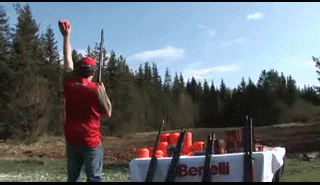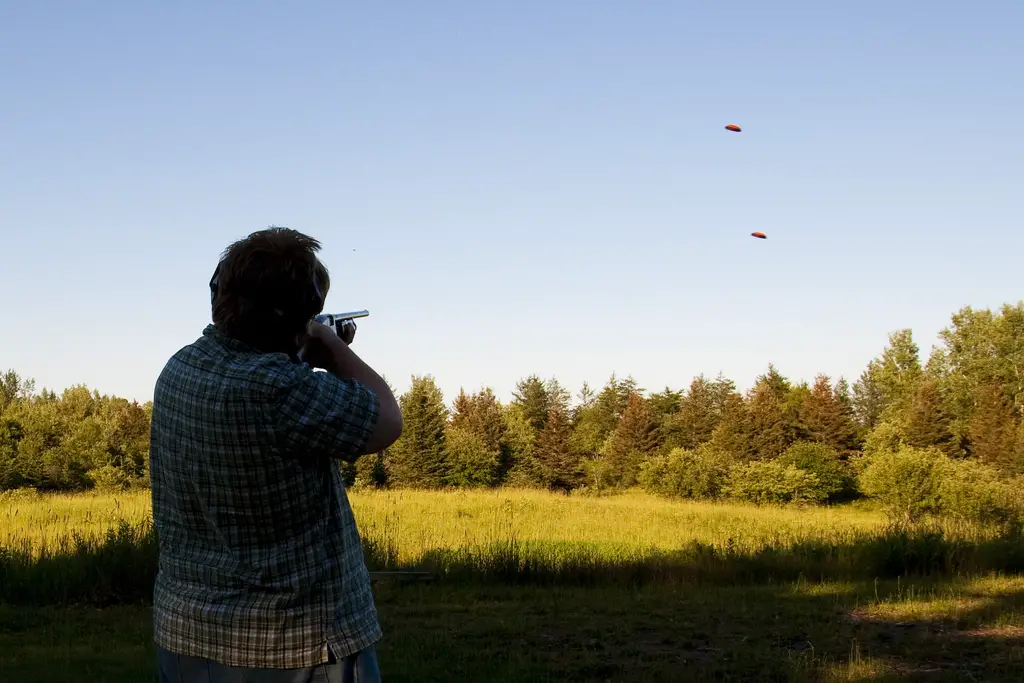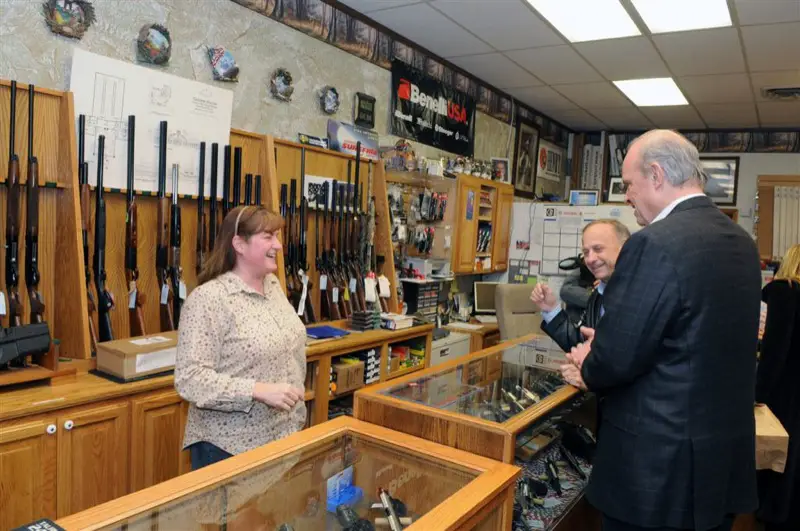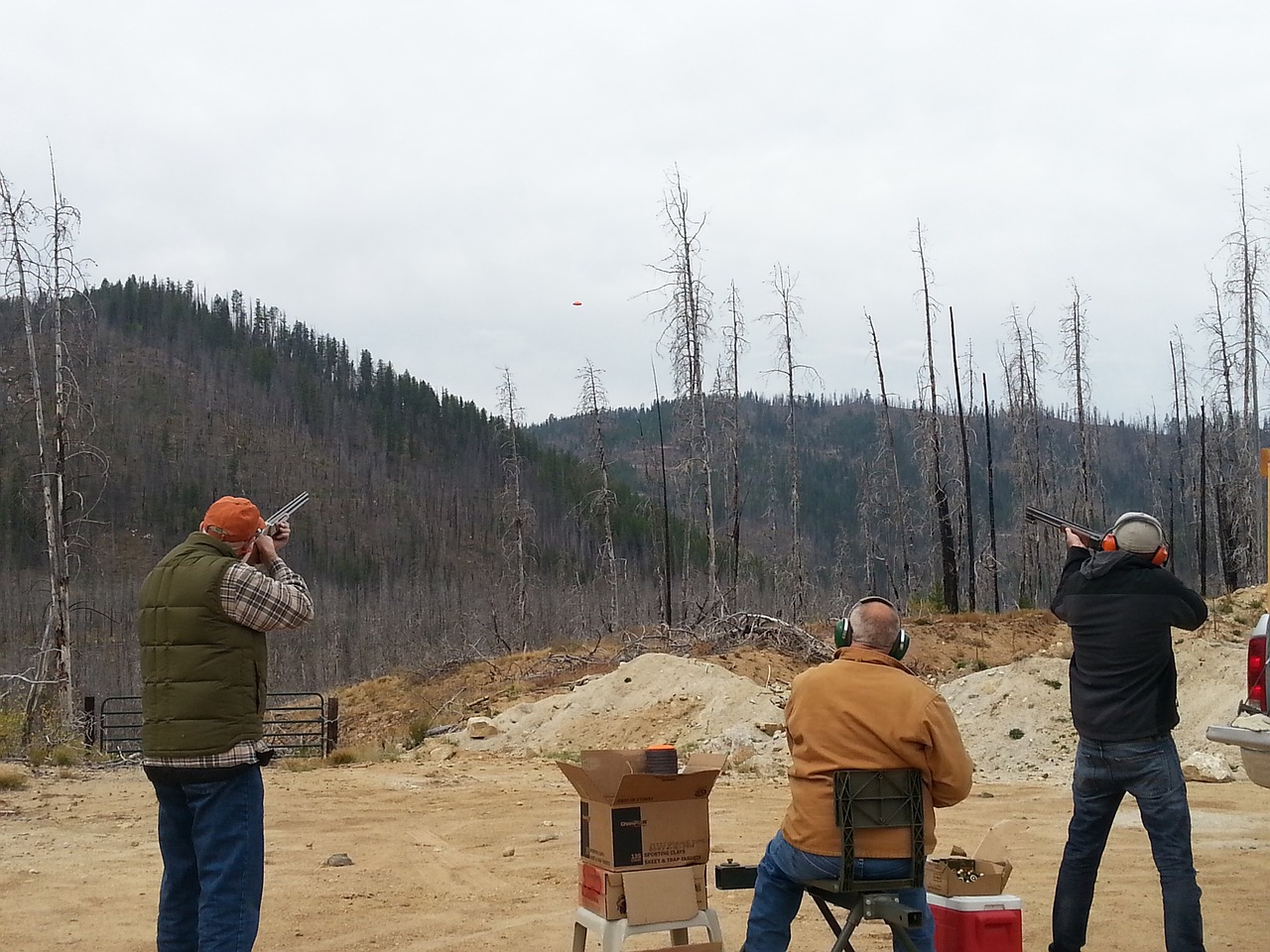Jeeves! Oh, Jeeves! Warm up the Rolls Royce and get the helicopter ready. Today we’re visiting the country estate for some clay pigeon shooting!
*This post may contain affiliate links. As an Amazon Associate we earn from qualifying purchases.
Is this the way you imagine most clay pigeon shooting trips coming about? There’s a highbrow perception around this classic shooting sport, but it’s no longer just for the rich and famous.
Clay pigeon shooting does, in fact, have aristocratic roots. But it’s been an affordable and safe way for aspiring shooting to gain confidence and knowledge with a shotgun since the 1800s.

Clay pigeon shooting has a lot of the challenges found in hunting, but it has one major upside — you don’t actually need to hunt! Whether you’re a total newbie to shooting sports, or a veteran shooter hoping to brush up their chops before a bird hunt, clay pigeon shooting could be the perfect activity.
But what if you really are a newbie? Not like an “I have never bird hunted, but I own seven rifles” newbie. Like an “I’ve never held a gun in my life, and frankly, they kind of horrify me” type of a newbie. Well, my friend, you’ve found the right article.
If you’re totally new to shooting sports, it’s probably good that you’re a little freaked out by guns. Any firearm can be a deadly weapon in the hands of an inexperienced or careless shooter. Fortunately, clay pigeon shooting can be an exceptionally safe sport and a perfect way to build your shooting skills.

Image by freepic.diller via Freepik
Still not convinced that blasting big powerful shotguns can be safe? Yes, we’re serious! Let’s break down some topics we’ll hit in this primer on clay pigeon shooting to show how you this sport can be safe, educational, and ridiculously fun.
What to know before you go
- Clay Shooting ABC’s
- A Spot of History
- How It’s Made: Clay Pigeon Edition
- What to Shoot and Why
- Trap, Skeet, and Sporting . . . What?

via Giphy
Lessons for the Field
- Why You Always Miss
- Let’s Talk Safety
- GEAR!
- When It’s Time to Compete
Now that you’ve got the rundown, let’s dive into some of the nitty-gritty on clay pigeon shooting!
Clay Pigeons? Like, Ceramic Birds?
OK, let’s get down to brass tacks. What is a clay pigeon? Are we really talking about launching some sort of little knick knack that should be sitting safely on grandma’s coffee table? And how do they fly, anyway? So, so, many questions . . .
Nope, they’re not birds.
These are actually ceramic shooting targets made specifically for shooting sports. They look a bit like an upside-down tea saucer (sorry again, Grandma!) but they’re optimized to fly well and break easily when hit with birdshot. So, wait, you shoot this thing with a gun?
How it all works (generally speaking)
There are a lot of ins and outs to the sport of clay pigeon shooting, but yes, shooting the pigeon with a shotgun is the general idea. The discs are thrown into the air by a mechanized unit called a trap. The shooter then tracks the pigeon like they would the flight of a game bird (see the connection?) and fires their weapon. At this point, it would be reasonable for you to start asking, “but, um, why?”
So what’s the point?
Good question, good question.Well, first and foremost shooting a clay pigeon with a shotgun is really fun. Like any sport, it’s a great way to take part in a community, get some activity in your life and generally clear your head. Clay pigeon shooting is a competitive sport (it’s in the Olympics) and is also excellent practice for upland bird and waterfowl hunters.
This can’t be safe, can it?
Sure, this all sounds like a real hoot. But can it really be safe to launch a bunch of tea saucers in the air and light them up with miniature cannon?
Surprisingly yes. Yes, it can be!
As with any shooting sport, gun safety is the absolute top priority at all times when clay pigeon shooting. We’ll go deep on safety considerations later. But for now, just know that clay pigeon shooting is a sport with incredibly high safety standards that takes place in a highly controlled setting with lots of expert supervision. But first, let’s have a quick history lesson.
Clay Shooting: It’s Old School!

Photo by Stephen Baker on Unsplash
Clay pigeon shooting may have a reputation as the fancy-pants branch of the shooting sports, but it’s not exactly well earned. The development of artificial flying targets actually came from common hunters who wanted the chance to shoot without needing permission to hunt on private land. Let’s wind back that clock.
When pigeons were actually pigeons
Pigeon shooting was a beloved sport of the English nobility long before the clay pigeon shooting came into existence. That’s why today’s targets are called pigeons. It’s also why the launching apparatus used today is still called a trap. In competition, the clays are often still called birds, and judges say “missed bird” after a bad shot.
Glass, feathers, and clay
Back in the day, shooting live pigeons was a privilege reserved only for the rich. It didn’t take long though for commoners to get in on the fun. The first artificial targets were glass balls filled with bird feathers. After they got sick of having glass and feathers rain overhead, shooters developed the first modern-style clay pigeons in the 1860s. They quickly took off (literally and figuratively).
It’s a hit!
By the early 1900s, clay pigeon shooting had become so popular that a trap shooting event was added to the Olympics. The sport was so popular that it even began branching out and taking on new forms including the various clay pigeon shooting disciplines we have today. More on those soon, but for now let’s look at how these suckers are made.
A Pigeon is Born

Image CC2 by Robert Emperley via flickr
The products used in today’s clay pigeon shooting sports have come a long way since the time we stuffed feathers into glass balls. Now there are several different types of clay pigeons available, and some of them aren’t even made out of clay. Let’s have a look at the type of pigeons currently used and how they’re made.
The classics
Traditional clay pigeons are made from a combination of limestone and a petroleum-based binder called pitch. Manufacturers blend about 80 percent limestone with 20 percent pitch to create a thick, sticky paste. This goo is then heat molded to create the beloved discs we like to blast while clay pigeon shooting.
Healthy choice
Traditional clays fly well and explode like it’s their job (it is), but they’re not great for Mother Earth. For a greener option, choose non-toxic clays. These are made from a combination of calcium bicarbonate, fly ash, heavy spar, plaster. They’re far better for the Earth and won’t leech residue from limestone into soil once they’re spent. There’s still one option though that’s a step greener.
A green (but not actually green) option
For the most Earth-friendly option consider choosing biodegradable pigeons. If you’re paying attention to our pretty pictures (ahem, ahem), then you can tell that clay pigeon shooting creates a lot of mess.
Biodegradable shooting clays are made from combinations of natural grains, sugars, seeds, and other edible goodies for wildlife. They may sacrifice some flight performance, but you may turn your shooting field in a viable hunting field with all the birds you’ll attract.
Weapons of Choice

Photo by Andy Falconer on Unsplash
Clay pigeons are pretty cool, right? You know what’s way cooler? Shotguns.
If you’re interested in clay pigeon shooting, then it’s important that you learn a thing or two about the different types of shotguns. There are three main types of shotguns you’ll see out clay pigeon shooting, and we broke them down into this cool chart for you:
Over/under
These guns got their name because they have two barrels stacked vertically. One’s over, one’s under. Get it? Often simply referred to as O/Us, these guns usually have a simple break action allowing the shooter to load on shell into each barrel easily. You’ll usually need to crack open the breach after two shots, but you’ll may also find these simple and effective guns work better in cold and wet weather.

Image by OpenClipart-Vectors via Pixabay
Pump
Pump shotguns use a sliding mechanism that ejects a spent shell after the shot and also pulls a new round into the chamber. The mechanism is controlled by pushing and pulling the forestock, making a pumping motion with the front hand. These guns usually hold three to seven additional rounds in a tube below the barrel and allow for quick reloading and more rapid firing.

Remington 870 Marine Magnum — Image CC2 by WickedVT via flickr
Semi-automatics
Shotguns with a semi-automatic action, usually called “semis” (we know, we know), eject a spent shell and load a new round into the firing chamber automatically. That means there’s no pumping, no breaching, no nothing from the shooter. Just shoot, acquire your new target, and shoot again. Semis are great for situations where quick shots are required, but they do have a lot of moving parts. And moving parts like to freeze and break.

Image CC2 by James Case via flickr
Choosing the type of shotgun can be a matter of budget, comfort, or convenience. When considering your first gun for clay pigeon shooting, it may also be worth considering what disciplines you’ll compete in. So, what’s the deal with these “disciplines” anyway?
One Target, Three Cool Sports
Over the years, fans of clay pigeon shooting have devised all manners of ways to get competitive. These days clay pigeon shooting breaks down into three main sports — trap shooting, skeet shooting, and sporting clays. Let’s look at the difference between the three disciplines.
Trap
During a round of trap shooting, clay pigeons are launched from a station (the trap) 15 meters in front of the shooter. They come out fast, like 65 miles an hour in the Olympics, but they only fly away from the shooter. They also fly at the same height, but at different angles every time.
Shooters move between five different stations that arch around the outside of shooting zone. Think of it like a golf driving range. You’ll have 5 shots at each station, for a total of 25 shots per round. Yeah, math!
Skeet
Skeet shooting is similar to trap shooting but focuses more on crisscrossing action. Imagine a U-shaped shooting range with a trap set at each end of the U. A “high house” is mounted 10 feet off the ground, and a “low house” is 3.5 feet off the ground. Clever, right? Shooters move through seven positions in a semi-circle, followed by one position in the middle.
When clay pigeon shooting like this, the discs will still come out at a predictable height, but they’ll be at varying angles. Another funky twist is that pigeons may come out one or two at a time. So stay sharp!
Sporting clays
Sporting clays is the most like a hunting experience and offers the greatest variation in shots. Shooters move through a course similar to golf course but tee off shotguns instead of drivers. Like trap and skeet, sporting clay shooters move through various stations.
With this style of clay pigeon shooting, however, the targets can come from just about anywhere. Don’t be shocked if they’re rolling through the dirt in one station and flying straight towards you at another station.
Now that we’ve studied up on the different forms of clay pigeon shooting let’s talk about something else that’s pretty important. How to actually hit one of these things.
Hittin’ The Mark

Michael Pullman of CBP’s Office of Air and Marine participates in the Trap Shooting event at the World Police and Fire Games in Centreville Virginia. Photo by James Tourtellotte
We’re not going to sugar coat this. Hitting a moving target is way harder than just hammering paper at a regular shooting range. Clay pigeon shooting brings a whole world of physics into the game that is honestly way over our heads. What we CAN tell you though are some fundamentals that you’ll need to start smoking clays whether you understand vectors or not.
Stand tall
The first step to effective clay pigeon shooting is setting a proper stance. Place the foot opposite of your dominant eye forward. Your weight should be on the ball of your front foot, and your leading foot should be pointing down range, that is, towards the clays. With this solid stance, you can confidently bring your shotgun up and prepare for a shot. But where should you look?
Eyes wide open
Firing a shotgun at a clay is a lot different from shooting a rifle. First of all, keep both of your eyes open. Though you’ll have the gun mounted to your shoulder and cheek like a rifle, that’s about where the similarities end. Don’t use the end of your barrel to aim like you would with open irons. Instead, think of the barrel like an extension of your eyes. Just like a camera . . . point and shoot.
Swing high sweet chariot
So you pointed, shot, and missed. Now what?
If you’re consistently missing clays, chances are you’re not following through on your swing. Think about a hockey player passing the puck. You’ve got anticipate the recipient’s movement, or else you’ll put it behind them. The same is true with birdshot and clay pigeons. Keep your gun moving even after the shot to ensure that you don’t pull up short. But whatever you do, SAFETY FIRST!
Safety. Let’s Say it Again. SAFETY!

So by this point, we agree that shotguns are awesome, right? Well, we hate to be a buzzkill, but they can also kill people. No discussion about clay pigeon shooting is complete without spending a good long while on safety concerns. No, we can’t teach you everything, because this is the Internet. But we CAN keep you pointed in the right direction . . . See what we did there?
Keep your breech breeched, bra.
One of the easiest ways to keep your gun safe it to keep it unloaded. This one’s kind of a no-brainer. What might also seem less obvious is to keep your action open whenever your gun is unloaded. This will help you stay certain that you’re clear and also let fellow shooters know you’re not an irresponsible ding dong.

Always act loaded
Keeping your breech open and having your gun unloaded is a good start, but let’s go further. Don’t go swinging your gun around or get lazy with your muzzle discipline just because your gun isn’t loaded. Always act like your gun is loaded and that it could go boom. This means keeping your muzzle safe, safety engaged, and your gun securely stowed when not in use.
You can’t unshoot
Here’s some folksy wisdom for ya: “Once you pull the trigger you can’t take it back.” Like much of the folksy wisdom out there it’s might sound a little dumb, but it’s also true. You MUST be 100% certain that your shooting zone is safe before touching one off. If there’s any question about down-range safety, then don’t shoot. Ever.
What You’ll Need, Where You’ll Find It

Image CC2 via Wikimedia
One of the best parts of shooting sports is the gear. This is especially true with clay pigeon shooting. From clays to shells to big shiny pistolas, there’s a lot you’ll need to get started. Here are a few suggestions to get you going.
Pigeons for days
You may think that the first thing on the list would be a shotgun, but you’d be wrong. For most new clay shooters the better move is to borrow a gun from a parent, friend, or mentor and offer to pick up a fresh box of clays as a thank you gift.
They are inexpensive, fun, and widely available from huge retailers like Amazon, and Walmart. We recommend the biodegradable kind if you can find them. Also, consider a way to fling them . . .
Let’s launch
Don’t think that you’re out of the game if you can’t get to a proper shooting range. Clay pigeon throwers are inexpensive and can turn any safe, wide-open space into a shooting range of your own.
They start as simple as single clay, hand-powered units (like dog ball throwers), and go all the way up through fully mechanize home skeet machines. We say start small; you’ll want to go slow at first.
Reload!
One thing you won’t move slowly with is ammo. It’s been said that another name for a rookie clay shooter is an “ammo waster.” So stock up. First and foremost make sure you are buying the right shells for your gauge of a shotgun.
Don’t worry about getting the most expensive box on the shelf. Do, however, stay consistent with your brand and model until you’re an old salt who ready for competition-grade gear.
Yeah, what about competitions anyway?
Competitive Clay Shooting

Let’s say you’ve got your safety skills on lockdown, you consistently smash clay at the range, and you’re ready for a new challenge. Competitive clay pigeon shooting may be just what you’re after. There can be some good money in it for pro shooters, but for most of us, competitions are just good fun. But how and where can you get involved in competitive clay pigeon shooting?
Skeetin’ and competin’
If skeet shooting is your favorite discipline then consider reaching out to your local branch of the National Skeet Shooting Association. This is a nationwide group that promotes all things skeet.
They hold competitions regionally that are open to competitors at all different skill levels. They also offer workshops and training sessions for those looking to build skills and confidence.



Nice clay shooting, sport.
If Sporting Clays are more your speed, then fear not. The National Sporting Clays Association offers similar events to those offered by the National Skeet Shooting Association but all on sporting clays courses. The two groups work in partnership to promote both shooting sports, and the NSCA also offers events for all abilities levels nationwide. Members also have access to a member magazine called Clay Target Nation.
Go for gold
One of the oldest and certainly most prestigious competitions for skeet and trap shooters is none other than the Olympics. The Olympics give the shooting sports an international spotlight and bring the world’s best shooters together for one helluva competition during each Summer Game. These guys and gals are scary good.
Clay Pigeons: More Fun Than Real Pigeons. And Cleaner!

Rach confirming that, yes, she is left handed — Image CC2 by Matt Taylor via flickr
If you’re reading this article right now, well we hate to say this, but you’re probably not going to the Olympics for shooting sports. But who knows, it’s good to dream right?
The good news is that you don’t need to have Olympics aspirations to start clay pigeon shooting. With some good, solid safety skills and a few lessons at your local shooting range, you can get started in the shooting sports and start literally blowing your stress away.
Top Three Tips

There’s a lot going on during a clay shooting session, and it can be hard to keep everything straight if you’re new. There’s gun safety, technique, gear, and . . . Wait what are we forgetting? But don’t panic! Keep these three top tips in mind to ensure a successful first trip to the shooting range:
Safety’s never second
Every shooter’s top priority is safety. Don’t ever think you’ll silly for being overly cautious with your shotgun. You may not hit a pigeon all day, but you’ll impress shooters-in-the-know with your safety skills.
Eyes on the prize!
Shotguns and rifles are both big, powerful guns that deserve a lot of respect. But they’re also super different. Don’t try to aim at a clay with the end of your barrel. You’ll probably miss. Instead, keep both eyes open and your gun solidly mounted to your cheek and shoulder. Let your eyes tell your gun where to shoot.
Keep swingin’, baby.
The idea of “swinging” your shot will take some practice, but it’s essential for success. Shoot a lot, and eventually, you’ll get the intuitive feeling that comes from moving with your target and allowing your muzzle to follow through. You’ll know you’ve got it when clays start exploding out in front of you all day.
Bad Habits That You Don’t Need

Clay Pigeon Skeet Traps Image CC3 by David R. Tribble via Wikimedia
It can be helpful to simplify things and just remember a few key points to get a day of shooting moving in the right direction. With that said, sometimes it’s just as important knowing what not to do. Keep an eye out for these common mistakes and nip them in the bud before they become common issues for your clay pigeon shooting.
Things to Avoid
- Unsafe Buddies – Everyone in your group must follow safe gun practices, such as: keeping the safety on, keeping shotguns unloaded when not in turn, and pointing the barrel at the ground and away from people at all times. Don’t include anyone in your group who can’t follow safety rules.
- Getting Frustrated – Hey! This is really fun, remember? You’re going to miss a bazillion pigeons when you start shooting. Don’t worry about it. That’s all part of the process.
- Ruining Your Gear – Shooting equipment is expensive. Shotguns can be ungodly expensive. Let your inner nagging parent ring true and take good care of your stuff. Routine maintenance on your firearm and clay thrower will not only make you a better shooter but also less poor.
- Being Too Shy – The shooting sports have tons of clubs and organizations that are packed full of nice people that want to be your friend. Get out there and enjoy the community. They (probably) won’t bite!
Load Up. Let’s Shoot!

If you’re serious about shooting clay pigeons, we have one last piece of advice. DO IT! Shooting is a lifetime sport that can introduce you to a world of inspiring challenges.
It can also provide a whole load of confidence as you build skills handling a big, powerful firearm. So find yourself and target range and start laying the smackdown on some clay!
What are your thoughts on shooting sports? Tell us your story in the comments!